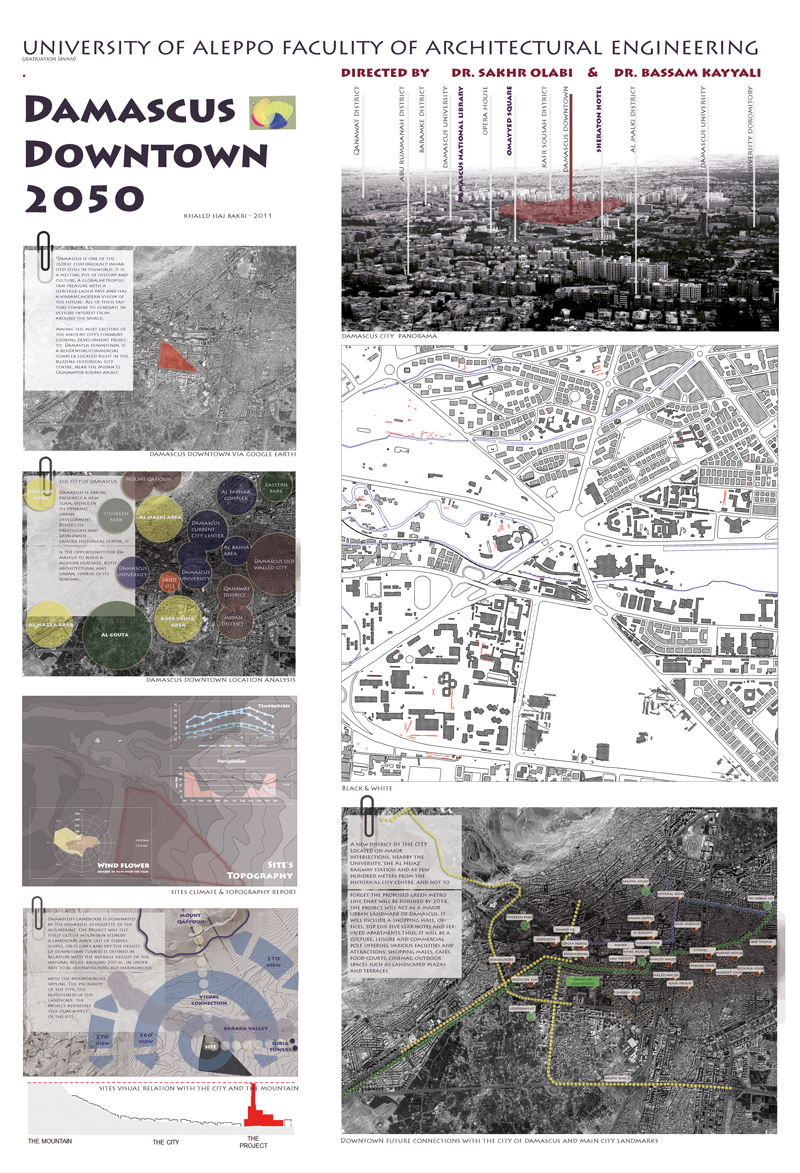DAMASCUS UPTOWN* 2050
Graduation Avan Project_2011_University of Aleppo, Syria
Graduation Avan Project_2011_University of Aleppo, Syria
5th Place_Urban Stratigies Awawrds_2013 _University of Applied Arts Vienna "Die Angewandte", Austria
Introduction
Being a Syrian citizen marks that you have been exposed to a pretty rich heritage of variety of cultures that shaped Syrian history. Being a Syrian Architect means that you truly acknowledge the value of that heritage, the magnitude of this value and the complexities that arose while dealing such one.
These complexities emerged and took shape due to unsolved issues of the 20th century concerning for example dealing with the old cities, or the massive urban explosion. By the beginning of the 21st century things appeared to change. And as we were, at the University of Aleppo, analyzing the evolving problems in depth on urban planning scale I was encouraged to take the lead and be part of the research on how to respond. I was awarded a scholarship by the DAAD-Germany in 2010 with five other nominated colleagues from my city to join two workshops in Syria and Germany. The workshops aimed to develop an approach on how to intervene in cities with historical complexities in the Middle East with comparisons to European cities like Damascus and Nurtingen.
These complexities emerged and took shape due to unsolved issues of the 20th century concerning for example dealing with the old cities, or the massive urban explosion. By the beginning of the 21st century things appeared to change. And as we were, at the University of Aleppo, analyzing the evolving problems in depth on urban planning scale I was encouraged to take the lead and be part of the research on how to respond. I was awarded a scholarship by the DAAD-Germany in 2010 with five other nominated colleagues from my city to join two workshops in Syria and Germany. The workshops aimed to develop an approach on how to intervene in cities with historical complexities in the Middle East with comparisons to European cities like Damascus and Nurtingen.

Insider Insight
When deeply examining the history of Damascus and by comparing it to Damascus 50 years ago, one can notice a huge change. Damascus has expanded rapidly into a megalopolis and the issues to consider today are way more complicated than ever. What is immediately realized is the lack of planning in the continued growth during this era.
While the health of a city can be measured by the health of its center, Damascus appears to be sick nowadays. The quality of the old city and even districts that were built in the fifties is not satisfying residents anymore. Lack of investment and development of these areas led to waves of immigrations to new districts far away from the center. The continuous growth is not only leaving the old residential quarters of the city abandoned but is also threatening wiping out ‘Gotah’ the Damascene gardens which were historically linked to the image of Damascus. The unhealthy transformation of these quarters from residential to commercial uses to fill the gap has been a major factor of devaluation of the quality of these spaces and a further reason for immigration.
The repositioning of residents to remote locations has led to the current crowded scene of the city. The old network of streets should now accommodate the transportation of more than two millions people daily to and from the city. An ambitious metro plan was set to provide an alternative reasonable transportation. Yet that will only solve part of the problem.
When deeply examining the history of Damascus and by comparing it to Damascus 50 years ago, one can notice a huge change. Damascus has expanded rapidly into a megalopolis and the issues to consider today are way more complicated than ever. What is immediately realized is the lack of planning in the continued growth during this era.
While the health of a city can be measured by the health of its center, Damascus appears to be sick nowadays. The quality of the old city and even districts that were built in the fifties is not satisfying residents anymore. Lack of investment and development of these areas led to waves of immigrations to new districts far away from the center. The continuous growth is not only leaving the old residential quarters of the city abandoned but is also threatening wiping out ‘Gotah’ the Damascene gardens which were historically linked to the image of Damascus. The unhealthy transformation of these quarters from residential to commercial uses to fill the gap has been a major factor of devaluation of the quality of these spaces and a further reason for immigration.
The repositioning of residents to remote locations has led to the current crowded scene of the city. The old network of streets should now accommodate the transportation of more than two millions people daily to and from the city. An ambitious metro plan was set to provide an alternative reasonable transportation. Yet that will only solve part of the problem.

Project Brief
I believe that the intervention should in the particular case of Damascus be in the form of regeneration of grey areas. Just in the middle of the city lies 43 hectares of grey areas and landfills that represent an opportunity to shape a new city center. The proposed plan considers providing affordable housing for young families and creating much needed open spaces that could preserve the city current residents and maybe draw back immigrants from the suburbs. Commercial spaces and offices would also be encouraged to relocate to the new quarters. The plan resembles a switch that is taking Damascus into modernity proving that it can compete globally as an iconic superior city in the future as it always did in the past.
I believe that the intervention should in the particular case of Damascus be in the form of regeneration of grey areas. Just in the middle of the city lies 43 hectares of grey areas and landfills that represent an opportunity to shape a new city center. The proposed plan considers providing affordable housing for young families and creating much needed open spaces that could preserve the city current residents and maybe draw back immigrants from the suburbs. Commercial spaces and offices would also be encouraged to relocate to the new quarters. The plan resembles a switch that is taking Damascus into modernity proving that it can compete globally as an iconic superior city in the future as it always did in the past.
These are the guidelines of the new city center of Damascus.




